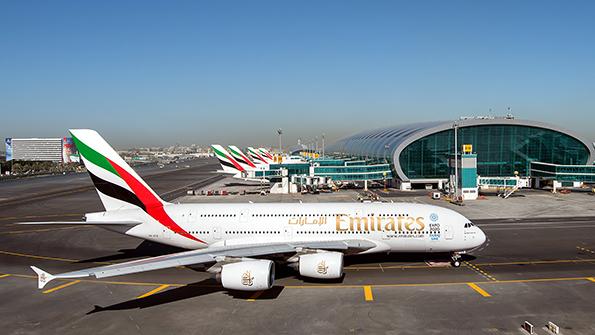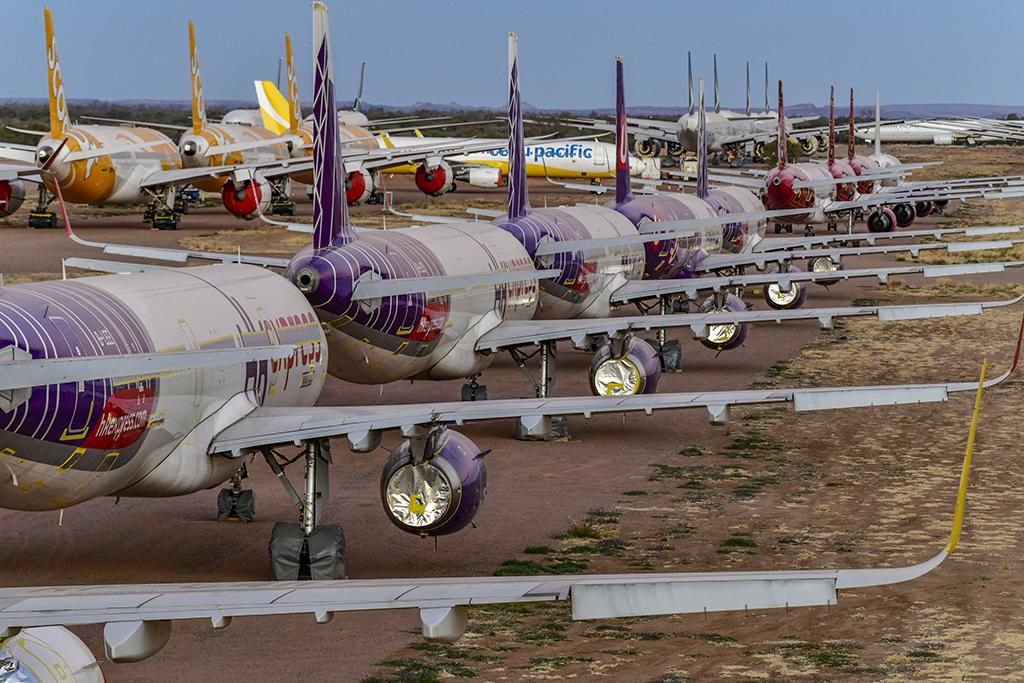
When the unthinkable happened nearly two years ago and commercial passenger air travel ground to halt, there was no playbook on what to do with aircraft quickly. The industry was in uncharted territory. “The Definitive Guide to Aircraft Parking” (or even “Aircraft Parking for Dummies”) did not exist. Since then, the industry has gained unexpected experience and accumulated several best practices.
Here are some lessons learned from airlines, MROs and OEMs from around the world.
AIRLINES
Emirates: “Our biggest concern with our parked or stored aircraft was potential cabin deterioration due to the extreme humidity and temperature buildup inside the cabins during the summer months,” says Ahmed Safa, divisional senior vice president of engineering. So, from the outset, the airline implemented “an aggressive maintenance regime for regular cabin inspections,” he says. The effort paid off because Emirates was able to preserve pre-pandemic conditions in cabins and return the aircraft to service without problems.
Safa says another key lesson was to ensure that an aircraft’s technical performance would be satisfactory when it was returned to service after extensive parking. Emirates worked closely with OEMs and “put a rigorous testing regime in place to return our aircraft to service, far over and above the prescribed maintenance requirements.”
Although the majority of its 262 Boeing 777s and Airbus A380s was grounded in March 2020 because the United Arab Emirates suspended passenger flights for eight weeks, the airline returned some aircraft to service for cargo and repatriation flights during that time. Since then, Emirates has steadily built back its fleet.
“We’ve returned our entire Boeing 777 fleet to service and almost half of our A380 fleet, and their technical dispatch reliability has so far been better than pre-COVID times,” Safa notes.
American Airlines: Similar to Emirates, American says it “implemented a reactivation process that went above and beyond what is required by the FAA or manufacturers,” an airline spokesperson says. For instance, pilots flew maintenance validation flights, which are not required by the FAA, before returning aircraft to service.
While aircraft were stored, American incorporated some scheduled maintenance tasks into the long-term storage reactivation plan for fleet preparedness. American says it evaluated its comprehensive maintenance schedule, and performing these tasks enabled a smooth reactivation process. This prevented bottlenecks when travel demand picked up and aircraft were needed back in service.
American did harvest some parts from parked aircraft—primarily engines and auxiliary power units—although others were removed as needed.
MROs
HAECO: From an MRO perspective, HAECO Chief Commercial Officer Richard Kendall says it was “challenging to meet each airline’s and regulator’s differing storage requirements beyond the normal 7-, 14-, 21-, and 30-day intervals.” However, he cites “pragmatic flexibility” from OEMs and operators in their requirements.
The MRO’s headquarters facility is based at the busy Hong Kong International Airport, so it focused on short-term parking and maintenance to keep aircraft on seven-day availabilities. Kendall says this required HAECO to “learn to manage the volume of maintenance work, maintenance documentation and ground movement to optimize the workload of fleets we managed at such an active international airport.”
In addition, he says: “Short-term stored aircraft require quite a lot of maintenance activity to keep them serviceable, but the corollary being that the reactivation work package will be smaller and quicker when an aircraft returns to service.”

Kendall notes that it would have been helpful to have had a more formalized continuous improvement program to “wring out more efficiency on our aircraft storage programs because even though parked aircraft demand the same overhead level of supervision, planning and quality efforts, parked aircraft do not generate the same MRO volume that active aircraft would.”
Another lesson learned was that aircraft parked in harsher conditions generally require more maintenance than active ones to return them to service. Kendall says reactivation inputs can take 2-6 weeks, depending on parking conditions. Some aircraft have turned up with hail damage, and others have required supplemental inspections of components, which he says deteriorated more rapidly than expected in storage.
Asia Pacific Aircraft Storage: Tom Vincent, managing director of Asia Pacific Aircraft Storage (APAS), located in Alice Springs, Australia, suggests that if aircraft do not have a return-to-service date, operators are better off placing them in long-term parking. “The long-term program drives more work up front,” he says. “However, it reduces the maintenance demand and overall cost due to the high weekly check requirements and short-term programs. There is additional work to reactivate the aircraft, but it is not materially longer.”
Customers need to understand that “it is just not plausible to say we need an aircraft [returned to service] in a few days,” Vincent says.
During the return-to-service program, licensed engineers—rated on aircraft type—manage the OEM Chapter 10 aircraft maintenance manual program as well as any other maintenance required. APAS follows the storage maintenance program plus additional items it has developed over the years—with “particular care to engines and pitot/static-systems testing, which have caused issues on aircraft returned to service in other nontraditional storage locations overseas,” Vincent says.
Alice Springs is in a dry area with low-lying vegetation, which helps dust suppression, making for good environmental conditions to store aircraft, he explains.
One hiccup APAS says it experienced with return to service was related to the supply chain, which affected almost every industry. To overcome that problem, APAS placed “very large orders for high-use materials and consumables,” which worked well so it could then “place longer-term orders without the stress of delivery timetables,” Vincent says.
APAS parked a total of 150 narrowbody and widebody aircraft at its peak in 2021 and has about 130 now. Vincent says the MRO has returned more than 90 to service and has received more than 90 for storage in the past year. “We have locked in returns, as well as deliveries, that will result in a net increase in storage numbers through 2022,” he says.
AerSale: AerSale reached a total of 600 stored aircraft at its peak, at its Roswell, New Mexico, and Goodyear, Arizona, facilities, “while taking in record-breaking deliveries in excess of 10 aircraft per day during our heaviest period,” compared to a more typical three per week, says Charlie McDonald, chief technical officer and president of the aircraft maintenance division.
The company says it would not have changed anything operationally about how it handled parking during the pandemic—noting that the parking surge happened at the same time customers suspended routine maintenance. That freed up labor to address the preservation activity. However, “pandemic-driven travel restrictions made the logistics of recruiting additional personnel extremely difficult,” McDonald says.
“The impact of the pandemic has subsided gradually since its peak in the spring of 2020, and we’re now experiencing an increasing demand for routine maintenance and MRO services associated with recommissioning stored aircraft,” he points out.
AerSale thinks its desert locations will help its storage business grow because “aircraft stakeholders that ended up with assets positioned long term in more humid-climate facilities are now finding out pricey contamination- and corrosion-related repairs significantly escalate stored-aircraft return-to-service expenses.”

OEMs
Boeing: The OEM’s biggest lesson learned was to maintain consistent communication with operators because each had unique challenges given their locations and operations, and each needed to ensure proper storage and reactivation processes.
Along the communication theme, Boeing held several teleconferences about parking and storage with operators, who, along with Boeing, shared fleet findings and lessons. One of the big issues was corrosion prevention, especially in moist environments.
“These fleet-wide discussions continued as operators began to return aircraft to service with the similar goal of sharing information to best de-preserve the fleet safely and efficiently,” a Boeing spokesperson says. That process included making sure service bulletins and airworthiness directives issued during the groundings were implemented during return-to-service maintenance.
Based on these fleet communications and learnings, Boeing “initiated a cross-model parking-and-storage standardization effort to share and implement fleet best practices and lessons learned” for each model, the spokesperson says. The new maintenance procedures were customized for climate and operating conditions and included added flexibility to address changing needs so operators could “park their airplanes for a variety of different time periods without having to resort to long-term storage programs.”
Boeing also used real-time information about flights before the grounding to visualize where parked aircraft should end up. This strategy helped the company develop dashboards to support the fleet based on aircraft model, age, utilization and lease status.
Embraer: Writing schedules with built-in flexibility is a lesson learned. Embraer published E-Jet family procedures for short-term parking (less than 60 days) and for longer periods as well as instructions on how to transition between programs.
“The degree of uncertainty brought by the pandemic and its associated economic impacts reinforced the need to have flexibility to analyze specific situations outside the published manuals so a customer could return its aircraft to service in a timely manner,” says Johann Bordais, president and CEO of Embraer Services and Support. This has included evaluating scenarios in which the parking procedures could not be followed exactly, so it provided alternative repair situations where applicable.
To help operators during the outbreak, Embraer published a “No Technical Objection” memo to stop calendar time intervals for scheduled maintenance when an aircraft is parked for up to six months.
Embraer also fielded several queries about switching to a Low-Utilization Maintenance Program (LUMP) versus a Standard-Utilization Maintenance Program (SUMP) while operating at a reduced schedule, so it published a fleet technical disposition to help operators better define program applicability. “The guidelines have prevented operators from unnecessarily changing their maintenance programs from SUMP to LUMP, thus avoiding the increased maintenance costs and over-maintenance,” Bordais says.
CONCLUSION
Aviation Week data shows that long-term aircraft storage peaked at more than 12,000 aircraft in May 2020. To put that in perspective, only 3,064 were in long-term storage in January 2020, according to Aviation Week data. That figure has dropped to more than 5,000 now. However, an additional 15% of the in-service fleet, or about 4,000 aircraft, is still classified as parked (on the ground for seven or more days) or parked-reserved (flying 1-2 days per week). Combined, 9,000 aircraft are still not back in full service.
The lessons to learn will continue, as expressed well from Emirates. “The pandemic taught us to be very agile in crafting our maintenance requirements based on the ever-changing market needs and continuously aligning our engineering efforts with the overall business needs,” Emirates’ Safa says. “The learnings that we’ve gained through this period—from technical aspects of storage to reentry to service, to our agile response—we will carry well into post-COVID operations.”





